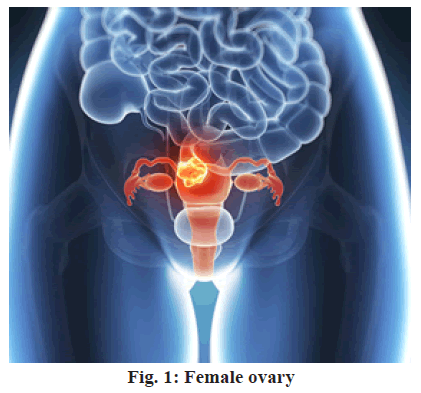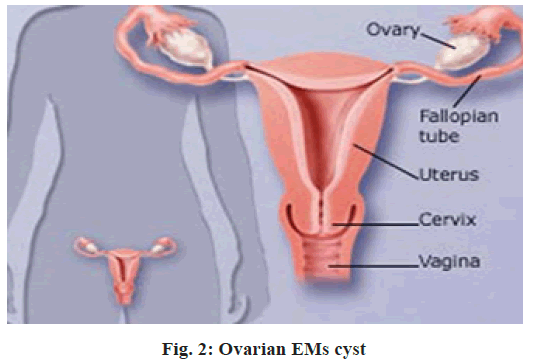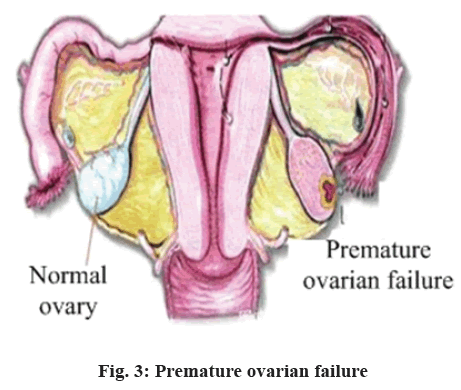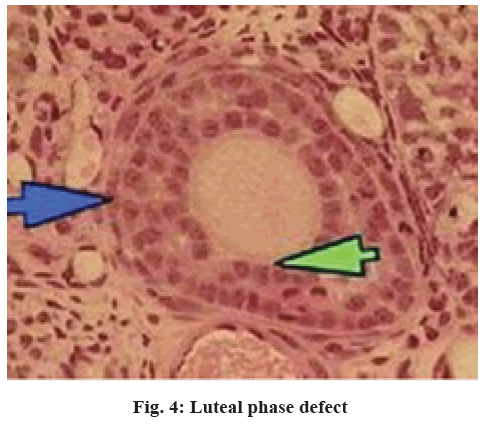- *Corresponding Author:
- Limei Liang
Obstetrics and Gynecology Department
The First Affiliated Hospital of Bengbu Medical College
Bengbu 233003
China
E-mail: liang99yb@sina.com
| This article was originally published in a special issue, “Trends in Therapeutic Management of Various Clinical Conditions II” |
| Indian J Pharm Sci 2021:83(2)Spl issue;141-146 |
This is an open access article distributed under the terms of the Creative Commons Attribution-NonCommercial-ShareAlike 3.0 License, which allows others to remix, tweak, and build upon the work non-commercially, as long as the author is credited and the new creations are licensed under the identical terms
Abstract
This study was to investigate and analyze the impact of laparoscopic ovarian endometriosis cystectomy on ovarian reserve function. A total of 20 patients undergone with laparoscopic unilateral ovarian teratoma (mature cystic teratoma) cystectomy and 80 cases with ovarian endometriosis cyst given laparoscopic ovarian cystectomy were regarded as the control group and the research group, respectively. Patients in the research group were divided into four group, group A (n=20, unilateral ovarian endometriosis cyst, cyst diameter <5 cm), group B (n=20, unilateral ovarian endometriosis cyst, cyst diameter ≥5 cm), group C (n=20, bilateral ovarian endometriosis cyst, bilateral cyst diameter <5 cm) and group D (n=20, bilateral ovarian endometriosis cyst, at least one lateral cyst diameter ≥5 cm). Levels of serum follicle stimulating hormone, luteinizing hormone and estradiol for patients among groups were observed and compared. Meanwhile, follow up profiles including basic serum follicle stimulating hormone, menstruation recovery and natural pregnancy for patients at stage III at 6 mo postoperatively, at stage IV after the first return of menstruation and at 1 y postoperatively were performed, respectively. Follicle stimulating hormone levels in group C and group D after operation were significantly higher than those before operation, showing p<0.05; while luteinizing hormone and estradiol levels in group C and group D after operation were significantly lower than those before operation, showing p<0.05. No significant difference was displayed on each hormone level of patients in group A, group B and the control group between pre operation and post operation, showing p>0.05. No statistical significance was indicated on hormone levels among groups when ages and types of bilateral ovarian endometriosis cyst were observed in layering, showing p>0.05. Comparing the control group, infertile patients before operation in group A, group B and group presented a higher postoperative pregnancy rate, showing p<0.05; but postoperative pregnancy rate in group D was lower than that in the control group, showing p<0.05. Laparoscopic ovarian endometriosis cystectomy suggested certain influences on ovarian reserve function. Most patients could recover at 1 y postoperatively and the postoperative pregnancy rate for fertile patients could be significantly enhanced by adding gonadotropin releasing hormone agonist, a medicine after the operation.
Keywords
Laparoscopic ovarian endometriosis cystectomy, ovarian reserve function, impact investigation
In recent years, with the development of social economy, improvement of people’s living standard, people’s health issues become more prominent as living habit, dietary structure and natural environment are constantly changing. Endometriosis (EMs) is a common disease in gynecology and ranks a high incidence among reproductive women. However, still there was no unified theory at present, for its pathogenesis. Mainly regulated by central nervous system-hypothalamus-hypophysis, the ovary is able to secrete sex hormone through mutual regulation, interaction and interplay, so as to further maintain female secondary sex characteristic and normal fertile function[1]. As the important female gonad organ, the ovary (fig. 1) not only exerts crucial effects on female endocrine metabolism and sex hormone metabolism systems, but also is a crucial organ for maintaining female sex characteristic and reproduction. In EMs, ovarian EMs cyst (fig. 2) is a common one, accounting for about 45 % in pelvic EMs and able to induce chronic pelvic pain or infertility, which can severely influence the living quality of reproductive women[2].
It is of vital importance for female that the ovary can be protected on the reproduction requirement or must for reserving normal reproductive endocrine function. Ovarian reserve function is available for the growth and development of follicle in the ovarian cortex area as well as the formation of fertilizable oocyte. Indexes, including follicle stimulating hormone (FSH), luteinizing hormone (LH) and estradiol (E2) levels can be utilized to evaluate the ovarian reserve function. This study was to investigate and analyze the impact of laparoscopic ovarian EMs cystectomy on ovarian reserve function. Clinical data of 100 females in reproductive ages, who were hospitalized and undergone with the laparoscopic treatment in the Department of Gynecology in our hospital between October 2013 and October 2016, were recruited as research subjects in this study. Their ages were ranging from 22 y to 45 y, with average age at (30.6±4.5) y. All patients had the right to be informed and signed the informed consent. Those patients were divided into the research group (80 cases) and the control group (20 cases). The research group was divided into four groups, group A (n=20, unilateral ovarian EMs cyst, cyst diameter <5 cm), group B (n=20, unilateral ovarian EMs cyst, cyst diameter ≥5 cm), group C (n=20, bilateral ovarian EMs cyst, bilateral cyst diameter <5 cm) and group D (n=20, bilateral ovarian EMs cyst, at least one lateral cyst diameter ≥5 cm). Laparoscopic ovarian EMs cystectomy was conducted in the research group. Meanwhile, the control group was taken with laparoscopic unilateral ovarian teratoma (mature cystic teratoma) cystectomy. Relevant data for patients showed the comparability in both group, with p>0.05. Laparoscopic ovarian EMs cystectomy was conducted on patients in general anesthesia and their vital signs were monitored rigorously during the operation. Then, patients were placed in bladder lithotomy position and positions of abdominal skin, vulva and vagina were disinfected routinely and covered with disinfectant wipes. Catheter and uterine manipulator were placed simultaneously and smooth puncture by veress needle on umbilicus was feasible to form CO2 pneumoperitoneum kept in 10 mmHg- 14 mmHg. A length of about 10 mm on umbilicus skin was cut transversely[3]. Afterwards, 10 mm trocar was punctured into abdominal cavity and laparoscope was placed for careful abdominal exploration. Blunt separation and sharp separation on adhesion were performed and the normal anatomical positions of uterus, fallopian tube and ovary were recovered at the same time[4]. In the weak positions of ovarian surface, the diluent of pituitrin at 1:20 was injected in the ovarian tissue and capsule wall interstitial tissue to establish water cushion. Brief electrocoagulation was conducted on surface regions using electrocantery at about 3 cm apart from ovarian hilum along the vertical axis orientation of the ovary, which was available to make blunt distraction on electrocoagulation depressions or cut the cortex into the capsule wall[5]. Ovary cortex of incision superior border was lifted with assistant forceps holder and separation on the interspace between ovary cortex and capsule wall was handled by the scissor so as to expand the incision into a half ring, reaching haft cyst circumference. Partial cortex which need to be retained was clamped by handling tong after producing one separation surface, tumor body was pushed by tong back in the opposite direction and the separated capsule wall by blunt separation was drawn out from outside the abdominal cavity. It should be paid attention, during the separation to prevent the rupture of ovarian tumor and to take a complete separation on capsule wall for pathological test. Continuous suture and locking stitch suture in 2.0 absorbable synthetic suture as well as 8 suture in 3 stitches were adopted for tackling with exudation and bleeding on separation surface[6]. Normal saline was used to rinse the pelvic cavity, the tubes were removed after exhausting CO2 and absorbable lines were utilized to suture the incision positions, at the same time drainage strip was placed and catheter was indwelled in the incision position of left lower abdomen[7]. Consistent postoperative fluid infusion and antibiotic therapy were performed on all patients after operation. Taking the practical situation as evidences, Gonadotropin releasing hormone agonist (GnRH-a) (zoladex) was applied on patients in the research group at 5-8 d postoperatively[8-12]. Levels of serum FSH, LH and E2 for patients among groups were detected at 3-5 d of menstrual cycle preoperatively, at 6 mo postoperatively for patients at stage III, at 3-5 d of menstrual cycle after the first return of menstruation for patients at stage IV and at 3-5 d of menstrual cycle at 12 mo postoperatively. SPSS 21.0 statistical software was employed for data process; (x̄±s) for measurement data and t test for intergroup comparison. p<0.05 was considered statistical significance. As shown in Table 1, Table 2 & Table 3, it was demonstrated that FSH levels in group C and group D after operation were significantly higher than those before operation, showing p<0.05; while LH and E2 levels in group C and group D after operation were significantly lower than those before operation, showing p<0.05; No significant difference was displayed on each hormone level of patients in group A, group B and the control group between pre operation and post operation, showing p>0.05. No statistical significance was indicated on hormone levels among groups when ages and types of bilateral ovarian EMs cyst were observed in layering, showing p>0.05. Comparing the control group, infertile patients before operation in group A, group B and group presented a higher postoperative pregnancy rate, showing p<0.05; but postoperative pregnancy rate in group D was lower than that in the control group, showing p<0.05.
| Time | Group A | Group B | Group C | Group D | The control group |
|---|---|---|---|---|---|
| Before treatment | 7.32±1.61 | 7.35±1.62 | 7.50±2.28 | 7.78±1.92 | 6.65±0.65 |
| Postoperative 6 mo or after the return of menstruation | 7.11±1.52 | 7.16±1.44 | 8.51±1.88 | 10.35±1.32 | 6.66±1.64 |
| Postoperative 12 mo | 7.16±1.67 | 7.17±1.65 | 7.13±1.78 | 7.02±1.05 | 6.65±0.76 |
| p value | >0.05 | >0.05 | <0.05 | <0.05 | >0.05 |
Table 1: Changes of Serum Fsh Levels among Groups before Operation and After Operation (mIU/mL, x̄±s)
Time |
Group A | Group B | Group C | Group D | The control group |
|---|---|---|---|---|---|
| Before treatment | 6.41±2.10 | 7.34±2.56 | 8.58±3.22 | 8.78±1.39 | 6.22±0.94 |
| Postoperative 6 mo or after the return of menstruation | 6.72±1.93 | 6.58±1.39 | 6.85±1.86 | 6.10±1.74 | 6.65±0.67 |
| Postoperative 12 mo | 6.78±1.35 | 6.99±1.68 | 6.87±1.45 | 6.81±1.33 | 6.61±0.78 |
| p value | >0.05 | >0.05 | <0.05 | <0.05 | >0.05 |
Table 2: Changes of Serum Lh Levels among Groups before Operation and After Operation (mIU/mL, x̄±s)
| Time | Group A | Group B | Group C | Group D | The control group |
|---|---|---|---|---|---|
| Before treatment | 80.56±20.09 | 88.39±49.16 | 104.39±50.43 | 103.45±46.74 | 69.51±4.21 |
| Postoperative 6 mo or after the return of menstruation | 87.45±32.26 | 78.63±18.16 | 92.76±18.23 | 94.16±35.24 | 107.26±10.41 |
| Postoperative 12 mo | 88.83±23.74 | 85.26±32.04 | 97.65±22.64 | 99.05±37.77 | 107.76±11.22 |
| p value | >0.05 | >0.05 | <0.05 | <0.05 | >0.05 |
Table 3: Changes of Serum E2 Levels among Groups before Operation and After Operation (pg/mL, x̄±s)
At present, laparotomy and laparoscopy are adopted to diagnose and treat EMs. Researches have indicated that following laparoscopic ovarian cystectomy, there also exist decrease of ovarian reserve function and premature failure of ovarian function (fig. 3). Influence factors of ovarian function probably can cause This study was to investigate the impact of the treatment with laparoscopic ovarian EMs cystectomy combined with GnRH-a and compare the changes of serum FSH, LH and E2 levels before operation and after operation. Also layered analysis was performed according to the size and type of chocolate cysts. Meanwhile, follow up of basic serum FSH, LH and E2 levels, menstruation recovery and natural pregnancy for patients at stage III at 6 mo postoperatively, patients at stage IV after the first return of menstruation and at 12 mo postoperatively was performed, respectively (Table 4). The results displayed that after ovarian EMs cystectomy, there was a decrease of ovarian reserve function, but most patients could recover into normal status after half a year. Moreover, one of the important content of treating hyperprolactinemia, influence on the generation of follicle, reduction of oocyte quality, defect of granular cell steroid hormone synthesis, luteinized unruptured follicle syndrome and luteal phase defect (fig. 4), which have attracted extensive attentions.
| Group | Menstrual conditions before operation | Menstrual conditions after operation | Pregnancy conditions | |||||
|---|---|---|---|---|---|---|---|---|
| Menstrual period (d) | Menstrual cycle (d) | Menstrual period (d) | Menstrual cycle (d) | Infertile cases before operation (n) | Pregnancy cases (n) | Pregnancy ratio (%) | Pregnancy interval time between pre operation and post operation | |
| Group A (n=20) | 5 | 28.2 | 5 | 28 | 32 | 29 | 96.7 | 7.0±1 |
| Group B (n=20) | 4.8 | 27.3 | 4 | 27 | 26 | 26 | 100.0 | 8.2±1 |
| Group C (n=20) | 4 | 27 | 4.2 | 27 | 45 | 44 | 97.8 | 9.5±1 |
| Group D (n=20) | 5 | 28 | 5 | 28 | 38 | 26 | 68.4 | 9.1±1 |
| Control group (n=20) | 5 | 30 | 5.1 | 29.6 | 30 | 27 | 90.0 | 9.0±1 |
Table 4: Changes of Menstrual Cycle and Pregnancy among Patients before Operation and After Operation
ovarian EMs cysts in operation is the serious operation risk assessment before operation, the protection of ovarian tissues as far as possible during the operation and evaluation and detection in ovarian function after operation. Treatment with Zoladex after operation to patients with EMs and infertility could significantly improve the pregnancy rate and active guidance of fertilization in good time should be performed. It was concluded that laparoscopic bilateral ovarian EMs cystectomy suggested certain influences on ovarian reserve function. Generally, patients could recover at 1 y postoperatively and the postoperative pregnancy rate for fertile patients could be significantly enhanced by adding GnRH-a medicine after the operation, showing great promotion significance.
This study was to investigate the impact of the treatment with laparoscopic ovarian EMs cystectomy combined with GnRH-a and compare the changes of serum FSH, LH and E2 levels before operation and after operation. Also layered analysis was performed according to the size and type of chocolate cysts. Meanwhile, follow up of basic serum FSH, LH and E2 levels, menstruation recovery and natural pregnancy for patients at stage III at 6 mo postoperatively, patients at stage IV after the first return of menstruation and at 12 mo postoperatively was performed, respectively (Table 4). The results displayed that after ovarian EMs cystectomy, there was a decrease of ovarian reserve function, but most patients could recover into normal status after half a year. Moreover, one of the important content of treating ovarian EMs cysts in operation is the serious operation risk assessment before operation, the protection of ovarian tissues as far as possible during the operation and evaluation and detection in ovarian function after operation. Treatment with Zoladex after operation to patients with EMs and infertility could significantly improve the pregnancy rate and active guidance of fertilization in good time should be performed. It was concluded that laparoscopic bilateral ovarian EMs cystectomy suggested certain influences on ovarian reserve function. Generally, patients could recover at 1 y postoperatively and the postoperative pregnancy rate for fertile patients could be significantly enhanced by adding GnRH-a medicine after the operation, showing great promotion significance.
Conflicts of Interest:
The authors declared no conflict of interest.
References
- Ye LH, Fang YQ, Tian GQ, Ye SJ. Study on the effects of ovarian reserve function by combination treatments of laparoscopic cystectomy and GnRH-a in ovarian endometriotic cyst. Prog Obstet Gynecol 2014;23(3):171-4.
- Yang Q. Effect of laparoscopic endometrial endometrial cyst removal on ovarian storage function and fertility. Guide Chin Med 2020;18(12):101-2.
- Li CZ, Wei DY, Wang F, Wang HQ, Yang CR. Impact on ovarian reserve function by different homostasis methods during laparoscopic cystectomy in treatment of ovarian endometrioma. Zhonghua Fu Chan Ke Za Zhi 2013;48(1):11-5.
- Yang XH, Ji F, AiLi A, TuerXun H, He Y, Ding Y. Effects of laparoscopic ovarian endometriosis cystectomy combined with postoperative GnRH-a therapy on ovarian reserve, pregnancy and outcome recurrence. Clin Exp Obstet Gynecol 2014;41(3):272-5.
- Wang DD, Yang Q. Influence on ovarian reservation with two different stripping methods after laparoscopic ovarian endometrioma cystectomy. J China Med Univ 2013;11(6):561-3.
- Yang XH, Aili AXZ, Ding Y. Influence on the ovarian reserved function after laparoscopic cystectomy combined with GnRH-a with ovarian endometrioma. Xinjiang Med J 2012;14(8):11-6.
- Liu CM, Huang YZ. Objective to analyze the effect of laparoscopic ovarian endometriosis cyst removal on ovarian reserve function and fertility. J Clin Med Lit 2018;5:37.
- Choi C, Kim WY, Lee DH, Lee SH. Usefulness of hemostatic sealants for minimizing ovarian damage during laparoscopic cystectomy for endometriosis. J Obstet Gynecol Res 2018;44(3):532-9.
- Zhang J, Zhou YF, Li B, Jian P, Xiao Y. Influence of various hemostatic methods on ovarian reserve function in women with ovarian endometriotic cyst treated by laparoscopic cystectomy. Zhonghua Fu Chan Ke Za Zhi 2009;44(8):583-7.
- Li J, Lv J, Wang YJ, Wang ZH. Influence of various hemostatic methods on ovarian reserve function in women with ovarian endometriotic cyst treated by laparoscopic cystectomy: a systematic review. Chin J Evid Based Med 2015;15(7):833-9.
- Li CZ, Liu B, Wen ZQ, Sun Q. The impact of electrocoagulation on ovarian reserve after laparoscopic excision of ovarian cysts: a prospective clinical study of 191 patients. Fertil Steril 2009;92(4):1428-35.
- Mao HQ. Effect of laparoscopic bilateral ovarian endometriosis cystectomy on ovarian reserve function and reproductive function. Matern Child Health Care China 2014;29(15):2387-9.








